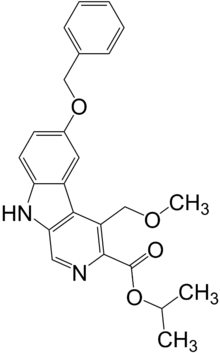 | |
| Clinical data | |
|---|---|
| ATC code |
|
| Pharmacokinetic data | |
| Elimination half-life | 3.4 hours (IV), 7 hours (oral) |
| Identifiers | |
| |
| CAS Number | |
| PubChem CID | |
| ChemSpider | |
| UNII | |
| KEGG | |
| ChEMBL | |
| CompTox Dashboard (EPA) | |
| Chemical and physical data | |
| Formula | C24H24N2O4 |
| Molar mass | 404.466 g·mol−1 |
| 3D model (JSmol) | |
| |
| |
| (verify) | |
Abecarnil (ZK-112,119) is an anxiolytic drug from the β-Carboline family. It is one of a relatively recently developed class of medicines known as the nonbenzodiazepines, which have similar effects to the older benzodiazepine group, but with quite different chemical structures. It is a partial agonist acting selectively at the benzodiazepine site of the GABAA receptor.[1]
- ^ Ozawa M, Nakada Y, Sugimachi K, Yabuuchi F, Akai T, Mizuta E, et al. (March 1994). "Pharmacological characterization of the novel anxiolytic beta-carboline abecarnil in rodents and primates". Japanese Journal of Pharmacology. 64 (3): 179–187. doi:10.1254/jjp.64.179. PMID 7912751.